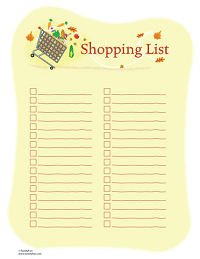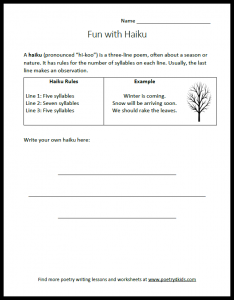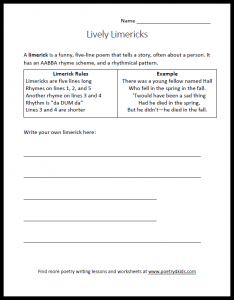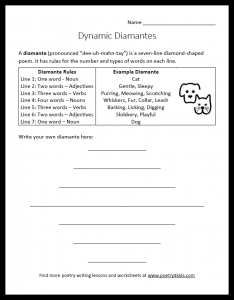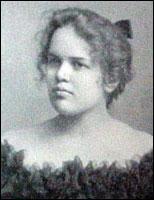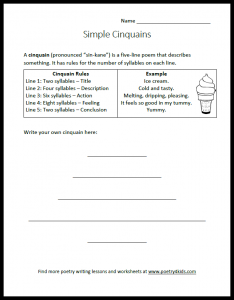If you would like to recite a poem for an audience – whether you are reciting a poem that you wrote yourself, or a poem by someone else – there are many different ways to go about it. Here are some of the things that will help you learn to recite poetry like an expert.
Choose a Poem that “Speaks to You”
When choosing a poem to recite, be sure to pick a poem that you really like. The more you like the poem, the more fun you will have learning and reciting it. Whether it’s a funny poem, a serious poem, a sad poem, a sports poem, a spooky poem, a jump-rope rhyme, or even a love poem, if it’s a poem that “speaks to you” – a poem that makes you feel something – you are going to enjoy sharing it with your audience.
It’s Okay to YELL!
There are lots of “right ways” to recite a poem, but in my opinion there is only one “wrong way.” The wrong way to recite a poem is to use your normal, everyday, “inside voice.” When you use your “inside voice,” you only speak loud enough for those closest to you to hear what you are saying. When you recite a poem, you need to speak loudly enough for everyone in the room to hear you.
Of course, if you really want to mess it up, you can also hold the poem in front of your face so no one can see your lips moving, making it that much harder for people to hear you. Oh, and look down at your shoes. When you speak, your voice travels in whatever direction you are facing. If you are looking at your shoes, your shoes can hear you really well, but other people might not.
So the first and most important thing to know when you want to recite a poem is that you really need to face your audience and use your “outside voice,” even if you are inside. In other words, it’s okay to YELL when reciting a poem. If anyone ever asks you why you were yelling when you recited a poem, please tell them Kenn Nesbitt said it was okay.
Memorize the Poem You Plan to Recite
To recite a poem well, it’s important to have it firmly committed to memory. If you don’t have the poem memorized, you are more likely to make mistakes when reciting it, even if you have it written on a piece of paper in front of you. Memorizing it will help make your recitation as good as possible.
I find that the best way to memorize a poem is to read a printed copy out loud as many times as possible. Depending on the length of the poem, you may have to read it out loud 10 or 20 times, or possibly even more, but each time you read a poem out loud, you will remember a little more of it.
How to memorize a poem:
- Get a printed copy of the poem.
- Look at the poem and read it out loud.
- Turn it over so you can’t see it.
- Recite as much of it as you can remember, from the beginning.
- Repeat steps 2 through 5 until you can recite the entire poem from memory.
Other Ways to Recite a Poem
While it’s okay to just YELL when you recite a poem, here are several other things you can do that might make it even better:
- Look for the voice of the poem, and speak in that voice. In other words, if it’s a poem about a cowboy, see if you can put on a cowboy accent. If it’s a poem about a monster, try using the scariest monster voice you can. If it’s a poem about a baby, an old person, or just some crazy character, think of what that person might sound like and try to speak in their voice.
- Rap the poem. Some poems have a rhythm built into the words. When you’re read a jump-rope rhyme, or any other rhythmical poem, you may find that it’s suitable for rapping. If you want to have even more fun with it, try reciting it to a drum beat or to music. Watch this video for an example how I recite poems to music: https://youtu.be/CkoOSfNjc40
- Recite it with a friend. Many poems have more than one voice. That is, a poem might have different speaking parts – such as the narrator, a mother or father, a teacher, a child, etc. – making it easy to split up and be read by two or more people. Even if it’s not, perhaps you and a friend could take turns reading every other line.
- Put on a play. If a poem tells a small story, you can perform it in much the same way that you can perform a play. You can create sets and props, and even wear costumes. Make it a drama! Or a comedy! Or a musical! Visit this link for an example of how a poem can be turned into a play: https://youtu.be/Meyq2pgCG-g
- Run around, wave your hands, say it like you mean it. Don’t just limit yourself to the ideas I’ve given above. Recite the poem in any way that seems best to you. If that means sitting in a chair, or jumping up and down, or stomping back and forth, or even dancing, that’s okay. Just put some feeling into it and “read it like you mean it” to give the best performance you can.
Have Fun!
However you decide to recite a poem, the most important thing is that you have fun doing it. So pick a poem, memorize it, practice reciting it a few different ways to see what works best, and then have fun sharing it with your audience!

